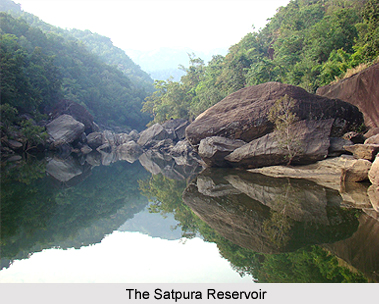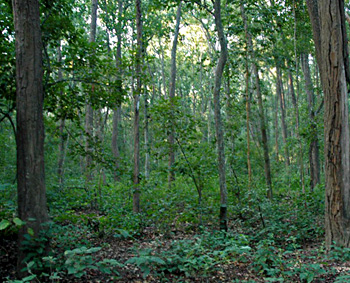 Geography of Mandla District in Madhya Pradesh consists of a rugged high tableland in the eastern part of the Satpura mountain range. The most important range of the Satpura ranges in the district is Maikal Hills, which forms a watershed between western and eastern parts of the state. It is well known in ancient Sanskrit Literature as the source of Narmada River. The spurs and sub-ranges of the Maikal hills divide the region in the east of the district into a number of valleys and table-lands.
Geography of Mandla District in Madhya Pradesh consists of a rugged high tableland in the eastern part of the Satpura mountain range. The most important range of the Satpura ranges in the district is Maikal Hills, which forms a watershed between western and eastern parts of the state. It is well known in ancient Sanskrit Literature as the source of Narmada River. The spurs and sub-ranges of the Maikal hills divide the region in the east of the district into a number of valleys and table-lands.
There is low altitude in the south-west corner of Mandla District which consists of a compact block of about two hundred good villages, known as the `Haveli` or the rich and wheat-growing tract round Hirdenagar, and `Pathar` or the open wheat plain round Nainpur. The extreme upper valley of the Narmada in Dindori and Niwas tehsils is an undulating plain, without much forest, broken by curious flat topped hills, which enclose patches of fertile black soil. A long spur of the Amarkantak, starting from north to Shahpura, separates the upper Narmada valley from the narrow, but fertile valley of river Kharmer.
To the south of the Kharmer valley lies the fine plateau containing the Baiga Chak and a long and rugged strip of Sal forest. The mean height of this plateau is over 850 metres. In Niwas tehsil, Narmada River flows through a rugged and inaccessible tract between high, rocky banks, till it enters the level rice tract near Mandla. Thereafter, it traverses through nearly 30 kms of the forest and hill country, and runs almost parallel to the Mandla-Jabalpur District road for few kilometres. The southern portion of the eastern Mandla tehsil is covered by the undulating grass plains of Raigarh District -Bichhiya tract. In this area are the forest sanctuaries of Kanha Tiger Reserve and Kisli - the home of countless deer and antelope and variety of other wild fauna, which attract tourists from everywhere. This tract is spotted with several isolated blocks of Sal forests of the Phen and Banjar valleys.
Mandla District extends over the highest plateaus of the Satpura ranging from 500 metres to 500 metres above mean sea level. Thus, the climate of Mandla District is characterized by hot summer season and general dryness except in the southwest monsoon season. The year may be divided into four seasons. The cold weather season from December to February is followed by the hot weather season from March to about the middle of June. The period from mid-June to September is the southwest monsoon season. October and November constitute the post monsoon or retreating monsoon season. There is a steady increase of temperature after February. May is the hottest month with the mean daily minimum temperature at around 41 degree Celsius and the mean daily minimum at 24 degree Celsius. On individual days during the summer season, the day temperature may go above 44 degree Celsius.
During the monsoon season, relative humidity generally exceeds 75 percent. The air becomes drive after the withdrawal of the southwest monsoon. The driest part of the year is the summer season when in the afternoons relative humidity is less than 25 percent. During the monsoon, season skies are generally clouded or overcast. In the rest of the year, skies are mostly clear or lightly clouded. Winds are in general light. Southwest monsoon winds blow from directions between southwest and northwest.
Geography of Mandla District includes several important rivers and their tributaries. Mandla District lies almost entirely in the catchments of river Narmada and its numerous tributaries. The Pathar tract is drained by a small tributary of Wainganga River. It is forming the southwest boundary of the district. The extreme north and northwest of Dindori District tehsil are watered by the Johilla River and Mahanadi River, which eventually find their way into Ganga River. The Narmada flows along the greater part of the district and Banjar is one of its main tributaries.
Narmada is the principal river of Mandla District. It rises at Amarkantak in Shahdol District and enters the district from the north-eastern side. The actual source of the Narmada is a spot of great sanctity. In its winding course through the district, the river generally flows between high and rocky banks, except for some distance near Mandla, where it flows through a rich and fertile plain. Near Mandla the river flows on a rocky bed and so numerous are its currents that this place has come to be known as Sahastradhara or thousand flow. The main tributaries of the Narmada in the district are the Banjar, the Halon, the Burhner, the Kharmer, the Balai, and the Hingara.
 Banjar is the most important tributary of river Narmada in the district. Its basin contains some of the best Sal forests of the district. Helon a tributary of Narmada waters the plains of Raigarh-Bichhiya. Kharmer a tributary of Narmada River waters the plains in the middle and south of Dindori tehsil. It flows eastward for 55 kms along a narrow valley and joins the Narmada at Keolari. Gaur river, which rises in Mandla district, forms for a short distance its boundary with Jabalpur District, and joins the Narmada in the latter district. In addition, the Narmada River also receives the waters of innumerable smaller streams throughout Mandla District. Among the southern tributaries, mention may be made of Machnar, Chakrar, Seoni District and Tar, which drain the northern slopes and valley of Maikal hills. Narmada and its tributaries are usually confined between rocky banks, sometimes rising to over 30 meters in height.
Banjar is the most important tributary of river Narmada in the district. Its basin contains some of the best Sal forests of the district. Helon a tributary of Narmada waters the plains of Raigarh-Bichhiya. Kharmer a tributary of Narmada River waters the plains in the middle and south of Dindori tehsil. It flows eastward for 55 kms along a narrow valley and joins the Narmada at Keolari. Gaur river, which rises in Mandla district, forms for a short distance its boundary with Jabalpur District, and joins the Narmada in the latter district. In addition, the Narmada River also receives the waters of innumerable smaller streams throughout Mandla District. Among the southern tributaries, mention may be made of Machnar, Chakrar, Seoni District and Tar, which drain the northern slopes and valley of Maikal hills. Narmada and its tributaries are usually confined between rocky banks, sometimes rising to over 30 meters in height.
Geography of Mandla District mainly comprises Archaeans, Lametas, and Deccan Traps of recent formation. The older metamorphic rocks of the district include granite, granite gneiss`s, hornblende Schist, quartz, mica schist, lime-silicate rocks, Pegmatite and Charnockite. The Dharwarian rocks of Mandla District are represented by Chilpi Ghat group, which comprises phyllite, dolomites, quartzite, pegmatite, mica schist and quartz. Arenaceous limestone resting horizontally on the denuded surface of schist deacon trap is the most extensively developed formation of the district. In many places, traps are covered by laterite in which segregation of alumina has resulted in bauxite deposit.
The overflowing trap mainly covers Mandla District, and its geology presents a little variety. Several minerals occur in the district. The high-grade dolomite occurs in the west of Banjar River. Low-grade iron ore occurs in Amwar village of the district. Fuller`s Earth and clay occurs at several places of the district. Good quality limestone, mica and bauxite of metallic grade are also found here.






